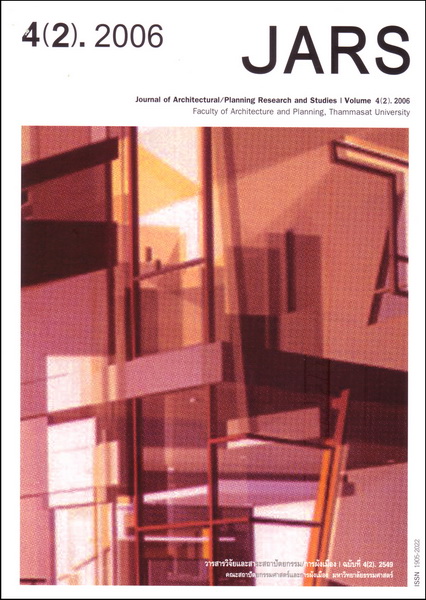Is Our City Livable and Healthy in the Post-SARS Era? Re-designing Healthy Cities – a Lesson from Hong Kong
Main Article Content
Abstract
The paper draws an attention on the academic debate on the pros and cons of compact city, one
that embraces a high-density and high-rise, mixed land-use urban form. The paper supports compact city
as a candidate for sustainable urban form by reviewing and discussing recent new initiatives from Hong
Kong in the post-SARS era that includes research and development efforts by academia and governments
on the evaluation and derivation of guidelines for design implementation and building management operations
at the urban design and building design levels. Similarly, innovative initiatives are also found in the
collective efforts by statutory bodies, developers and professionals to improve the standard and quality of
the habitable environment. The discussion is based on selected case studies from recently realized projects
in the residential market; as well as applied research programs undertaken by universities and government.
The summary is that recent efforts in Hong Kong show that there is confidence for a high density compact
city to be a livable and healthy city. In the paper, the reference to ‘health,’ ‘hygiene’ or ‘healthy buildings’
is a causal usage. The three terms project a layperson’s perception of the quality of the physical environment.
In this way, the terms have no specific medical connections.
Downloads
Article Details

This work is licensed under a Creative Commons Attribution-NonCommercial-NoDerivatives 4.0 International License.
All material is licensed under the terms of the Creative Commons Attribution 4.0 International (CC-BY-NC-ND 4.0) License, unless otherwise stated. As such, authors are free to share, copy, and redistribute the material in any medium or format. The authors must give appropriate credit, provide a link to the license, and indicate if changes were made. The authors may do so in any reasonable manner, but not in any way that suggests the licensor endorses you or your use. The authors may not use the material for commercial purposes. If the authors remix, transform, or build upon the material, they may not distribute the modified material, unless permission is obtained from JARS. Final, accepted versions of the paper may be posted on third party repositories, provided appropriate acknowledgement to the original source is clearly noted.
References
Bugliarello, G. (1994). Technology and the city. In Fuchs, R. J., et al. (Eds.), Mega-city Growth and the Future. Tokyo: United Nations University Press.
United Nations. (2002). Statistics year book. Retrieved from http://www.unstats.un.org/unsd.
Hong Kong Government. (2001). Census and Statistics Department. Retrieved from http://www.info.gov.hk/censtatd/.
Burgess, R. (2000). The compact city debate: A global perspective. In Jenks, M., et al. (Eds.), Compact Cities: Sustainable urban forms for developing countries. London: Spon Press.
Lau, S. S. Y. (2005). A report on the survey of urban lifestyle for young office workers in the urban centers Shanghai. Unpublished report. Shanghai: China.
Hui, E., Lam, M., & Ho, V. (2004). Land use policy and patterns in Hong Kong. In ENHR Conference. Cambridge, UK.
Lau, S. S. Y., et al. (2006). Reconsidering daylighting design paradigms for tall buildings in a densely built city. Architectural Science Review, 49, 285-294.
Swaid, H., & Hoffman, M. E. (1990). Climatic impacts of urban design features for high and mid-latitude cities. Energy and Building, 14, 325-336.
Golany, G. S. (1995). Urban design morphology and thermal performance. Atmospheric Environment, 30, 455-465.
Givoni, B. (1998). Climate considerations in building and urban design. USA: John Wiley & Sons.
Giridharan, R., Tai, J., & Lau, S. S. Y. (2005). A study of microclimate conditions in outdoor spaces of high-rise residential developments. In International Conference on Sustainable Buildings. Tokyo.
IBEC (2004). CASBEE for new construction. Tokyo: Institute for Building Environment and Energy Conservation (IBEC).
Levin, H. (2000). Design and construct of healthy and sustainable buildings. Proceeding of Healthy Buildings. Helsinki, 13-22.
UNCHS (1996). Istanbul declaration on human settlements. Retrieved from United Nations Center for Human Settlement Web site: http://www.unchs.org.
Steri, J., et al. (2000). New target values for IAQ and climate in Finland. Proceeding of Healthy Buildings. Helsinki, 531-536.
Follin, T. (2000). A method to create environmentally friendly and healthy buildings. Proceeding of Healthy Buildings. Helsinki, 569-574.
HK-BEAM Society. (2004). HK-BEAM 4/04 ‘New Buildings’: An environmental assessment for new buildings, version 4/04. Hong Kong: Author.
Jones, P. J., Vaughan, N. D., & Grajewski, T. (1997). New guidelines for the design of healthy office Environment. In BEPAC + EPSRC Conference. Abington, England.
Samuelsson, I. (2000). Quality assurance of the indoor environment in schools, offices and dwellings Proceeding of Healthy Buildings. Helsinki, 555-560.
Takano, T. (1998). What is a healthy city?. WHO-C.C.H.C.U.P.R. Monograph, 1. Tokyo: WHO Collaborating Center for Healthy Cities and Urban Policy Research.
IHCF. (1994). International Healthy City Foundation. Retrieved from www.healthycities.org.


